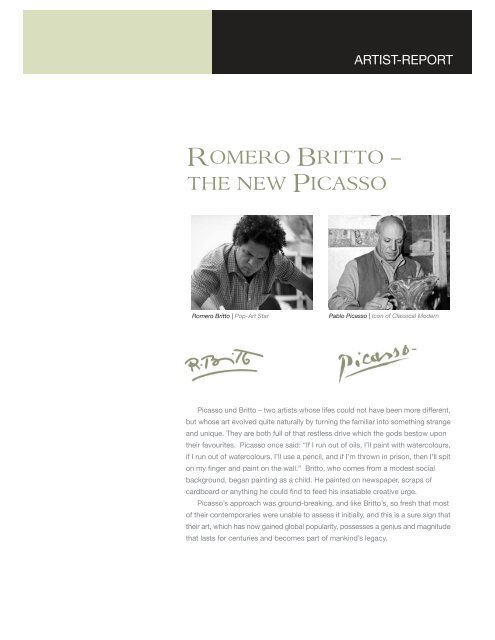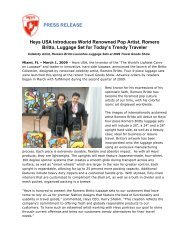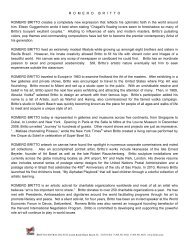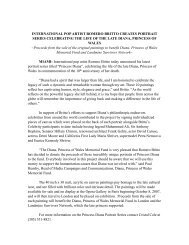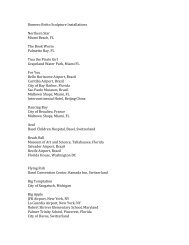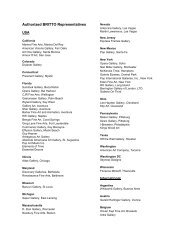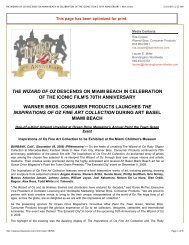Download - Romero Britto
Download - Romero Britto
Download - Romero Britto
Create successful ePaper yourself
Turn your PDF publications into a flip-book with our unique Google optimized e-Paper software.
ARTIST-REPORT<br />
ROMERO BRITTO<br />
THE NEW PICASSO<br />
<strong>Romero</strong> <strong>Britto</strong> | Pop-Art Star<br />
Pablo Picasso | Icon of Classical Modern<br />
Picasso und <strong>Britto</strong> – two artists whose lifes could not have been more different,<br />
but whose art evolved quite naturally by turning the familiar into something strange<br />
and unique. They are both full of that restless drive which the gods bestow upon<br />
their favourites. Picasso once said: “If I run out of oils, I’ll paint with watercolours,<br />
if I run out of watercolours, I’ll use a pencil, and if I’m thrown in prison, then I’ll spit<br />
on my finger and paint on the wall.” <strong>Britto</strong>, who comes from a modest social<br />
background, began painting as a child. He painted on newspaper, scraps of<br />
cardboard or anything he could find to feed his insatiable creative urge.<br />
Picasso’s approach was ground-breaking, and like <strong>Britto</strong>’s, so fresh that most<br />
of their contemporaries were unable to assess it initially, and this is a sure sign that<br />
their art, which has now gained global popularity, possesses a genius and magnitude<br />
that lasts for centuries and becomes part of mankind’s legacy.
Similarities between the works of <strong>Romero</strong> <strong>Britto</strong> and Picasso<br />
A genius can always be recognized by the fact that their work is incomparable<br />
to that of others. If we now consider <strong>Romero</strong> <strong>Britto</strong>’s similarities with<br />
Picasso, it is because he, like the Spaniard, has created a totally new and<br />
unique abstract style, and the development of his art and stylistic techniques<br />
often runs parallel to those of the greatest artist of the 20th century.<br />
Bust of Nefertiti in the original<br />
Digital abstraction of the bust of Nefertiti<br />
<strong>Britto</strong> and Cubism<br />
Like Picasso, <strong>Britto</strong>’s quest for a unique style found its expression in Cubism.<br />
Motifs we observe can be divided into surfaces and these surfaces re-assembled<br />
to form a picture, as demonstrated (left) in the digital abstract of the Nefertiti bust.<br />
Picasso’s most famous picture from his Cubist period is “Les Demoiselles d’Avignon”.<br />
Pablo Picasso<br />
<strong>Romero</strong> <strong>Britto</strong><br />
<strong>Britto</strong>’s early works, forerunners to the individual style which he was later to<br />
develop, feature a fragmentation of motifs into coloured surfaces, sometimes making<br />
them strongly redolent of Picasso’s works.
Pablo Picasso<br />
Pablo Picasso<br />
<strong>Romero</strong> <strong>Britto</strong><br />
<strong>Romero</strong> <strong>Britto</strong><br />
Motifs and Abstractions<br />
When trying to decipher an artist’s language, one inevitably comes up<br />
against their choice of motifs and how the abstraction ignites or extinguishes<br />
the viewer’s imagination. Here the two artists again display a close affinity<br />
which has not been learned or adopted, but which mirrors the natural development<br />
process of their artistic language.<br />
Pablo Picasso<br />
<strong>Romero</strong> <strong>Britto</strong><br />
Pablo Picasso<br />
<strong>Romero</strong> <strong>Britto</strong><br />
Expression<br />
Finally, when it comes to the impact of the paintings, there are again multiple<br />
similarities but also distinct differences. Many analogies can be seen in their proximity<br />
to nature, the primordial and intrinsic. The main differences can be found in the<br />
cheerfulness and zest for life which seems to emanate from almost all of <strong>Britto</strong>’s<br />
works. Picasso, on the other hand, lived through two world wars, the Spanish Civil<br />
War and several family tragedies, and his works sometimes hint at darker aspects<br />
of his psyche. Both artists are united by their common ability to make every line,<br />
every colour and every surface of their paintings seem to laugh or cry, but <strong>Romero</strong><br />
<strong>Britto</strong> ignites almost every single work with such an intense Brazilian vitality, as if<br />
he were a descendent of the sun god Helios himself, so that anyone who has a<br />
<strong>Britto</strong> hanging on their wall never needs to raise the blinds in a morning.
BRITTO – THE NEW PICASSO<br />
Pablo Picasso<br />
<strong>Romero</strong> <strong>Britto</strong><br />
Both Picasso and <strong>Britto</strong> integrated the essence of Cubism into their own artistic language and<br />
used it as their stylistic means of communication.<br />
Pablo Picasso <strong>Romero</strong> <strong>Britto</strong> <strong>Romero</strong> <strong>Britto</strong> – Drawing<br />
of Alfred Biolek<br />
A Stroke of Genius<br />
The affinity between Picasso and <strong>Britto</strong> is further documented in the genius of their line<br />
drawings. They are both masters in endowing the “strokes” of their line drawings with life and<br />
soul, and in the way they condense the essence of nature into a few “dashed-off” lines which<br />
are far more effective than any photograph.<br />
Pablo Picasso<br />
Pablo Picasso<br />
<strong>Romero</strong> <strong>Britto</strong><br />
Colours, forms, patterns<br />
The Spaniard Pablo Picasso and the Brazilian <strong>Romero</strong> <strong>Britto</strong> cannot – and do not wish to<br />
– ignore the colours of their sun-drenched homelands. They both have the impulse not to mix<br />
colours but instead to use dots, hatching and elements which allow a range of different shades<br />
to harmonize into one overall composition, just like in nature. Their aspiration is to create art<br />
that is to be felt as opposed to “read”.<br />
<strong>Romero</strong> <strong>Britto</strong>
BRITTO – THE NEW PICASSO<br />
Pablo Picasso<br />
Picasso’s “Le train bleu” was used as a<br />
backdrop for Diaghilev’s Russian ballet, and<br />
in its expression is similar to <strong>Britto</strong>’s “Love<br />
Blossoms”.<br />
<strong>Romero</strong> <strong>Britto</strong><br />
<strong>Britto</strong>’s “Love Blossoms” illustrates the<br />
exuberance of young lovers within nature.
Brief Biography of <strong>Romero</strong> <strong>Britto</strong><br />
<strong>Romero</strong> <strong>Britto</strong> on himself:<br />
“Ever since I was a child, I have felt driven to<br />
express my feelings in pictures. Painting has<br />
allowed me to create a personal fantasy world<br />
to live in. I would like to give back to the world<br />
a little bit of the happiness that I have been<br />
lucky enough to enjoy. We celebrate my art<br />
amongst friends, so that we can then do<br />
something to help those less fortunate than<br />
myself, particularly children.”<br />
1963 Born on 6 October in Recife/Brazil, the eighth of nine children<br />
1971 Starts to paint at a young age, using anything and everything as his canvas<br />
1977 First publication of his work and own exhibition in Brasilia<br />
1987 Move to Miami, where he still lives with wife, Cheryl and son, Brendan<br />
1989 Invitation from “Absolut Vodka” to join the legendary “Show Case”<br />
group of artists<br />
1990 Founding of his art industry, “<strong>Britto</strong> Central”<br />
from 1990 Worldwide success, with exhibitions in museums and galleries (including<br />
MoMA and the Guggenheim in New York). Spectacular projects such as the<br />
largest installation ever in Hyde Park, a 45 foot tall pyramid in celebration of<br />
the return of the King Tutankhamen Exhibit, the largest living canvas for Super<br />
Bowl XLI in 2007, and an exhibition at the Carrousel du Louvre in Paris in<br />
2008 and 2010.<br />
Brief Biography of Pablo Picasso<br />
Pablo Picasso on himself:<br />
“It is my destiny to work, to work myself breathless.<br />
I am action: my creativity is often a kind<br />
of rage. The ideas never stop flowing because<br />
they come from the sensations that I gather<br />
and the observations that I record.”<br />
1881 Born on 25 October in Málaga (Spain)<br />
1891 Studies under his father José Ruiz Blasco at the Art Academy in La Coruña<br />
1895 Studies at the La Lonja art school in Barcelona<br />
1901–1904 Melancholic Blue Period<br />
1905–1906 Picasso works on paintings of gamblers and acrobats which<br />
characterize his Rose Period<br />
1906-1907 His Black Period, where he falls under the influence of African art and sculpture<br />
from 1907 Appearance of cubist, stereometric forms (Analytical Cubism)<br />
from 1912 Picasso develops collages (Synthetic Cubism period)<br />
from 1920 Paints monumental nudes and antique themes (Classical Period).<br />
Creates drawings made up of simple outlines in an archaic style.<br />
At the end of the 1920s he combines surrealist motifs with cubist elements<br />
1935 Separates from Olga. Begins his relationship with Marie-Thérése Walter<br />
1936-1939 During the Spanish Civil War, Picasso supports the republicans<br />
and paints “Guernica”<br />
1943 Meets Francoise Gilot, who is his significant other between 1946 and 1953<br />
from 1950 Picasso creates paraphrases (new adaptations) of works by old masters<br />
1958 Marries Jacqueline Roque<br />
1973 Picasso dies on 8 April in Mougins, near Antibes (France)<br />
IMPRINT & COPYRIGHTS<br />
Editor/Curator: IWECO Boppard, Frank Gross, Simmerner Straße 12, D-56154 Boppard, Germany Design: IWECO Boppard, Annette Kämpf, Simmerner Straße 12, D-56154 Boppard, Germany<br />
Copyright: © 2011 IWECO GmbH, Boppard. All rights reserved. No part of this publication may be reproduced without written permission from IWECO.<br />
Picasso Images: Reproduction, including downloading of Pablo Picasso works is prohibited by copyright laws and international conventions without the express written permission of Artists Rights<br />
Society (ARS), New York Picasso Photographs: Reproduction, including downloading of Pablo Picasso works is prohibited by copyright laws and international conventions without the express written<br />
permission of Corbis, New York <strong>Romero</strong> <strong>Britto</strong> Images: Reproduction, including downloading of <strong>Romero</strong> <strong>Britto</strong> works is prohibited by copyright laws and international conventions without the express<br />
written permission of <strong>Britto</strong> Central Inc., Miami Florida Court of Registration: AG Koblenz HRB 1652<br />
Disclaimer: The use, particularly the copying or distributing, of this copyright-protected publication and any of the text or illustrations it contains is not permitted without the prior written approval of<br />
the above mentioned parties (IWECO, ARS, <strong>Britto</strong> Central) and is a punishable offence, providing that no exception is made in copyright law. In particular, storage and modification of the information in<br />
data systems is not permitted without the company’s approval. The use by third parties of the contact data legally required in the imprint for the sending of advertisements and information that is not<br />
expressly requested is forbidden. In the case that unrequested advertisements are received, for example spam, the site operators reserve the right to take legal action.<br />
© 2011, IWECO Werbe GmbH, Boppard – Germany, Printed in the USA


